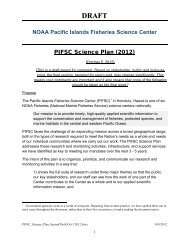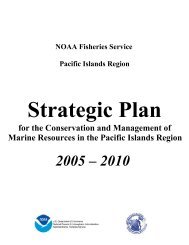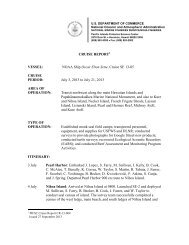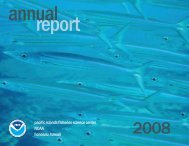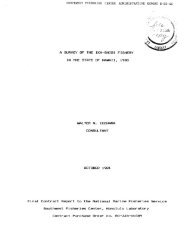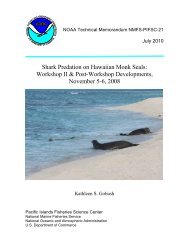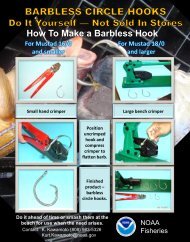Contingency Plan for Hawaiian Monk Seal Unusual Mortality Events
Contingency Plan for Hawaiian Monk Seal Unusual Mortality Events
Contingency Plan for Hawaiian Monk Seal Unusual Mortality Events
Create successful ePaper yourself
Turn your PDF publications into a flip-book with our unique Google optimized e-Paper software.
A-7<br />
the needle still and attach the extension set firmly. An assistant should connect the extension set to the<br />
syringe.<br />
Collect 35 - 105 cc of whole blood by slowly drawing upward on syringe. Bubbles in syringe indicate your<br />
needle/extension set or extension set/syringe connections are not secure. This should be corrected as it may<br />
lead to hemolysis and poor filling. When finished collecting blood, disconnect syringe from the extension<br />
set, and immediately remove needle from the seal.<br />
When filling tubes, remove caps (take care to keep inside top of cap from making contact with anything),<br />
tilt tubes and slowly push blood out of syringe and down side of tube to prevent lysis. First fill LTT and<br />
GNTT 3/4 full to allow <strong>for</strong> proper ratio of blood to anti coagulant, immediately replace cap, and mix the<br />
specimen by gently inverting the tube several times to thoroughly mix additive and blood. Fill scintillation<br />
or teflon vial (<strong>for</strong> toxicology) with 5-6 mL of whole blood. Then fill SST with remainder of blood. If<br />
special tubes <strong>for</strong> other studies are required, fill them accordingly.<br />
During restraint, closely monitor respiratory rate, cardiac rate, eyes, and body movements and temperature<br />
of the seal being handled. Changes in temperature, breathing, and heart rate, unresponsive eyes, seizures,<br />
muscle weakness or spasms, and rigid/flacid flippers may indicate severe stress or shock. If this happens,<br />
ABORT the procedure immediately. THE VETERINARIAN ON SITE WILL DIRECT<br />
EMERGENCY PROCEDURES AS NECESSARY. Emergency procedures may include:<br />
a) moving away from the animal to avoid any added stress<br />
b) using emergency equipment to establish an airway<br />
c) cooling the seal by drenching with water<br />
d) loading emergency drugs (see below)<br />
e) taking careful notes<br />
f) treating <strong>for</strong> emergency conditions as necessary, i.e., capture myopathy, dehydration, cardiac arrest,<br />
vomiting,<br />
wounds, seizures<br />
Notify Marine Mammal Research Program Chief of the situation as soon as possible.<br />
Emergency Drug Doses<br />
DRUG SEAL SIZE DRAW ADMINISTRATION<br />
DOPRAM (Doxapram<br />
hydrochloride; 20<br />
mg/ml) Pup or juvenile 10 ml<br />
DOPRAM (Doxapram<br />
hydrochloride; 20<br />
mg/ml) Subadult or adult 20 ml<br />
Give 5 ml, slow IV<br />
Repeat if needed<br />
Give 10 ml, slow IV<br />
Repeat if needed<br />
ATROPINE sulfate<br />
(1/120 gr) Pup or juvenile 1.5 - 3 ml Give 1.5 ml IV or 3 ml IM<br />
ATROPINE sulfate<br />
(1/120 gr) Adult 2.5 - 4 ml Give 1.5 ml IV or 3 ml IM<br />
EPINEPHRINE<br />
(1:1000) All sizes 5 ml<br />
Give 1 ml/100-200 kg IM or IV,<br />
repeat prn<br />
DEXAMETHASONE<br />
4 mg/ml All Sizes Give 10 ml /50-100 kg IM or IV<br />
FLUMAZENIL<br />
(Romazicon, 0.5<br />
mg/5/ml) Pup or juvenile 1 bottle (5 ml)<br />
FLUMAZENIL<br />
(Romazicon, 0.5<br />
mg/5/ml) Subadult or adult 1 bottle (5 ml)<br />
Give 2.5 ml slow IV (over 60 sec)<br />
Repeat in 2-3 min if needed<br />
Give 2.5 ml slow IV (over 60-90 sec)<br />
Repeat in 2-3 min if needed



